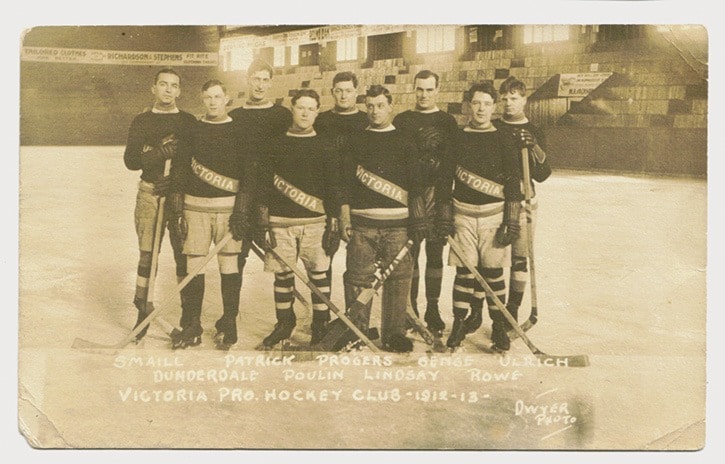It was the rule change to rule all rule changes.
A century ago, the innovative brothers Lester and Frank Patrick shaped the modern game of hockey, and they did it in Victoria.
But it wasn’t all rosy. When they opted to allow the forward pass, in the neutral zone only, they were scrutinized by the press and by other leagues. Even players “held a disdain” for the new rule.
Today, the Patricks are heralded for their innovations, which are used in the NHL and ice hockey leagues worldwide. But people are unaware of the staunch criticism they faced. They were told they were going to ruin the game. It’s captured in Craig H. Bowlsby’s new book 1913: The Year They Invented The Future of Hockey.
“The Patricks were always looking for ways to better the flow of the game, not necessarily to increase speed,” Bowlsby says. “They wanted to prevent stoppages. Goalies going down would kill the play, so that was obvious, and they allowed goalies to fall to the ice.”
Thusly they allowed the forward pass. Outside of hockey, the pass had already been adopted by the U.S.A. rugby union, as that sport morphed into football as we know it.
However, forward passing wasn’t accepted widely in hockey until as late as the 1930s.
Bowlsby’s 1913 chronicles not only the backlash Frank and Lester faced from newspapers and their main competition that season, the east’s National Hockey Association (which became the NHL in 1917), it also sheds new light on the brothers’ quarrels with each other. Their first significant disagreement was over the seven-man system.
“Frank tried to implement the six-man unit in 1913 but Lester said ‘no way.’ So when Frank said ‘no offside’ in the centre ice area, Lester had to back down,” Bowlsby said.
It was one of the few areas of the game the PCHA changed after the NHA. Lester refused to drop the seventh man and go to five skaters and a goalie. However, it worked as leverage for Frank to implement the forward pass in 1913-14, which Lester was also cold on. In fact, Bowlsby is almost certain Lester hated the forward pass.
Ironically, Lester relented soon into the 1913-14 season as his Victoria Pros proved the most capable of using the neutral zone pass in the PCHA. With it, they advanced from the PCHA to the 1914 Stanley Cup championship held in Toronto, though they lost to the Toronto Arenas/Blueshirts of the NHA. In a twist of fate, noted hockey historian Prime Minister Stephen Harper has simultaneously released a book this month on the beginnings of pro hockey in Toronto, including the 1914 champion Arenas.
“Frank and Lester both brought in the new ideas, and there was a dynamic between them, a tug of war,” Bowlsby said. “Frank championed some things, Lester others, and they didn’t always agree.”
At times they squabbled through the newspapers.
“Frank stated through The Vancouver Province: ‘there was no question it would be adopted.’ But two days later Lester repudiated that idea,” Bowlsby said.
“Shortly thereafter, (Lester) said in The Province on Dec. 1, 1913: ‘I am not greatly in favour of the new offside rule and will have to be shown where this rule will benefit the game before I will lend my support....’”
1913: The Year They Invented The Future of Hockey is available at Chapters.Indigo.ca.
James Bay to Oak Bay
The brothers Patrick brooded over new ideas, tweaking the game in their minds as much as possible before each season in the Pacific Coast Hockey Association, which they ran from 1911 to 1924.
Some rule changes were sketched out at Frank’s house in Vancouver, while others were debated in the Patrick family house on Michigan Street in James Bay. They implemented them on the artificial ice of the Patrick Arena in Oak Bay. The Patricks continued to tinker with the game until the PCHA folded in 1926, when Lester sold his Victoria Cougars, which became the NHL’s Detroit Cougars (Red Wings).
Picture this
Craig Bowlsby is a Vancouver-based hockey author. He started collecting old hockey photos which led him to 15 years of part-time research and the self-published 2006 book, Knights of Winter. He assembled 1913: The Year They Invented The Future of Hockey, based on the three years of research he put into his mammoth release earlier in 2013, Empire of Ice: The Rise and Fall of the Pacific Coast Hockey Association, 1911-1926.
Tired players
The forward pass sped up the game and ultimately led to another Patrick innovation, or “allowance,” to increase the roster and allow line changes. The same six players used to play the entire game.
Rugged rules
The Canadian Football League didn’t permit a forward pass in the Grey Cup until 1929.
